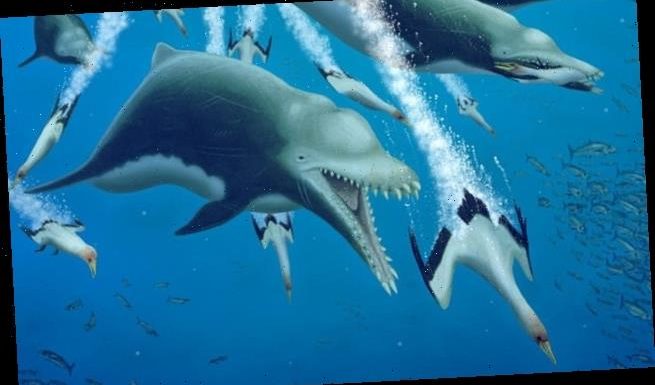Researchers have identified an almost-complete skeleton of a 4.8-metre (15.7-foot) long dolphin ancestor that lived in what is now South Carolina during the Oligocene epoch around 25 million years ago.
The species, christened Ankylorhiza tiedemani lived about 25 million years ago during the Oligocene in what today is South Carolina. It belonged to a group of large dolphins (Odontoceti) whose best-known modern representative is the orca (killer whale).
The anatomy of this fossil suggests that it was likely a top predator in its day. It shares several features with today’s baleen and toothed whales despite not being directly related to these groups, the authors report. This suggests that these animals evolved their shared swimming adaptations independently from one another, a phenomenon known as parallel evolution.
“The degree to which baleen whales and dolphins independently arrive at the same overall swimming adaptations, rather than these traits evolving once in the common ancestor of both groups, surprised us,” says Robert Boessenecker of the College of Charleston in Charleston, South Carolina, first author of the paper describing this fossil.
“Some examples include the narrowing of the tail stock, increase in the number of tail vertebrae, and shortening of the humerus (upper arm bone) in the flipper.
Comparison with lineages of seals and sea lions reveal that the two families went down very different evolutionary paths as they transitioned from a land- to a marine-based lifestyle. The initial differences between these lineages were slight, the team explains: Ankylorhiza’s ancestors had one extra row of finger bones in their flippers and a “locking elbow joint”. Still, these factors lead to them developing different swimming styles and skeletal structures.
Another thing the authors note is that Ankylorhiza is the first echolocating whale to become an apex predator. According to the team, it was “very clearly preying upon large-bodied prey like a killer whale”. Its extinction cleared an ecological niche that sperm whales and a lineage of shark-toothed dolphins (both extinct) evolved into. Later still, killer whales would evolve into the same niche around 1 or 2 million years ago.
Ankylorhiza was first described from a skull fragment found during dredging of the Wando River, South Carolina, in the 1880s. A nearly-complete skeleton was later unearthed in the 1970s. The one described in this paper was found in the 1990s by commercial paleontologist Mark Havenstein at a building site and donated it to the Mace Brown Museum of Natural History to allow for its study.
“Whales and dolphins have a complicated and long evolutionary history, and at a glance, you may not get that impression from modern species,” Boessenecker says. “The fossil record has really cracked open this long, winding evolutionary path, and fossils like Ankylorhiza help illuminate how this happened.”
Boessenecker says that there are “many other unique and strange early dolphins and baleen whales from Oligocene aged rocks in Charleston, South Carolina,” including fossils of juvenile Ankylorhiza and specimens of related species. Both filter-feeding and echolocation first appeared during the Oligocene, he adds, so these fossils should give us a very good peek into how they came to be.
The paper “Convergent Evolution of Swimming Adaptations in Modern Whales Revealed by a Large Macrophagous Dolphin from the Oligocene of South Carolina” has been published in the journal Current Biology.















